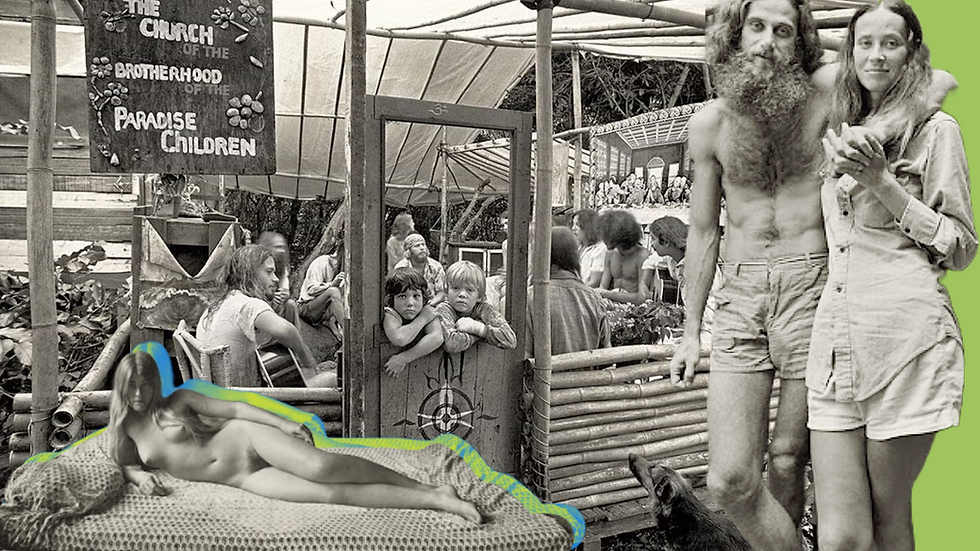Taylor Camp: A Bohemian Oasis in Hawaii
- dthholland

- Apr 21, 2024
- 3 min read

Nestled amidst the lush forests and pristine beaches of Kauai, Hawaii, there exists a fascinating chapter in the annals of countercultural history – the legendary Taylor Camp.
It began with thirteen hippies seeking refuge from the ongoing campus riots and police brutality in the United States. They were arrested for vagrancy but Howard Taylor, brother of movie star Elizabeth, bailed them out of jail and invited them to settle on a beachfront land he owned.

Taylor Camp—John Wehrheim’s photographs of the alternative community are an absolutely fascinating insight into early 70s 'hippie culture'

Life in Taylor Camp
Life in Taylor Camp was characterised by a unique blend of freedom, creativity, and communal spirit. Residents lived in makeshift structures – treehouses, tents, and driftwood shacks – constructed from salvaged materials found in the surrounding area. There were no rules or regulations, no electricity or running water. Instead, residents embraced a back-to-nature ethos, living off the land and forging deep connections with one another.

Daily life in Taylor Camp was a vibrant tapestry of artistic expression, communal meals, and shared experiences. Residents spent their days surfing the crystal-clear waves, practicing yoga on the sun-drenched beaches, and creating art inspired by the breathtaking natural scenery. Evenings were filled with music, drum circles, and impromptu gatherings around crackling bonfires, as the community came together to celebrate the beauty of life in paradise.

"In Taylor Camp, we were free to be ourselves – to explore, to create, to live in harmony with the land and each other. It was a truly magical time." - Banana Bill

The People of Taylor Camp
The inhabitants of Taylor Camp hailed from all walks of life, drawn together by a shared sense of adventure and a desire to live outside the constraints of mainstream society. Artists, musicians, hippies, and seekers of all stripes found refuge within its leafy confines. Among them were colorful characters like "Banana" Bill, a charismatic surfer and unofficial mayor of the camp, and "Barefoot" Bob, a barefoot philosopher with a penchant for storytelling.

Each resident brought their own unique talents and perspectives to the community, enriching its tapestry with diversity and creativity. From the aspiring musicians strumming guitars by the fire to the aspiring poets scribbling verses in the sand, Taylor Camp was a melting pot of artistic expression and unconventional living.

The End of an Era
As the 1970s wore on, the idyllic existence of Taylor Camp began to unravel. Increasing pressure from local authorities and conflicts with neighbouring landowners led to a series of legal battles and eviction notices. Despite valiant efforts to preserve their way of life, the residents of Taylor Camp were ultimately forced to abandon their beloved home in 1977.
"Leaving Taylor Camp was like leaving a piece of my soul behind. It may have been just a makeshift village on a remote beach, but to me, it was paradise." - Barefoot Bob

In 1973, the settlement faced condemnation, prompting its residents to gradually depart following legal defeats. By 1977, only a handful of residents remained. At that time, local authorities conducted a raid, leading to the eviction of the remaining occupants by the state. Subsequently, the camp buildings were set ablaze, reducing them to ashes. The site was subsequently converted into a state park and has since remained undeveloped.

These are just a sample of the imagery created, if you can get your hands on the book by John Wehrheim I strongly urge you to so.
“Taylor Camp wasn’t a commune,” Wehrheim writes in the introduction. “It had no guru, no clearly defined leadership, and never had a single voice. It had no written ordinances. It wasn’t a democracy. It was much more than that: a community guided by a spirit that created order without rules.”











































































































